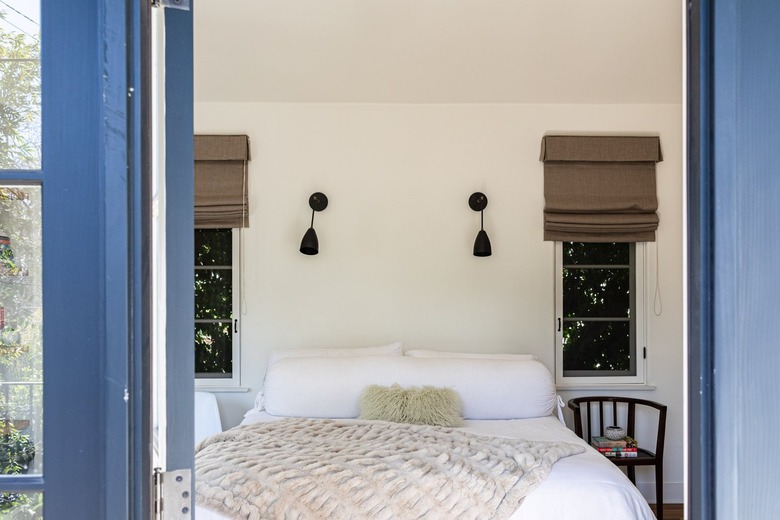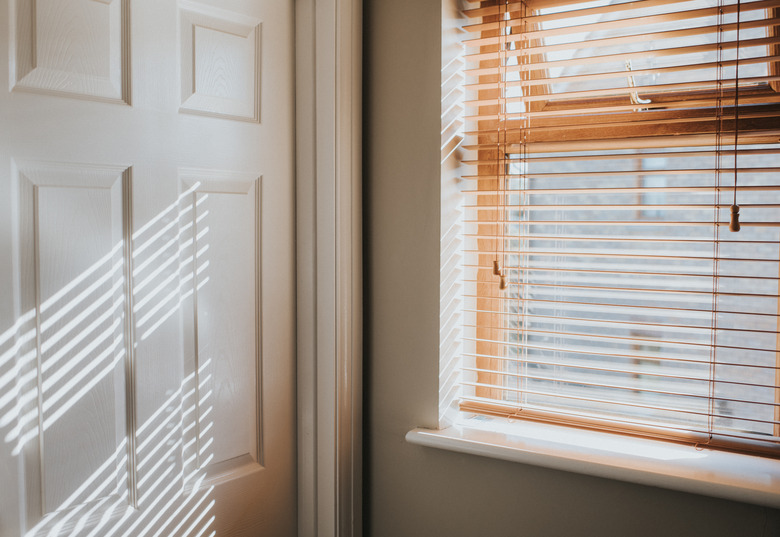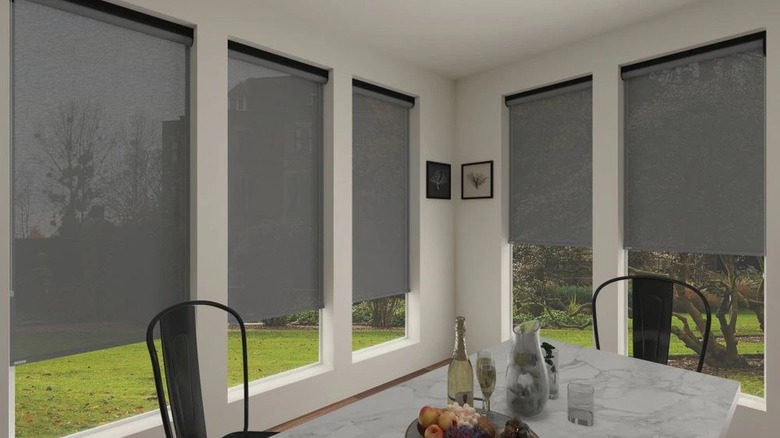How To Measure For Blinds And Shades
As it turns out, measuring for window coverings isn't quite as simple as getting out a measuring tape and writing down the length, width, and height of the window. Before you even start to measure, you have a lot of decisions to make — and one of the most important is whether you're going to go for an inside-mount or an outside-mount.
Whether you choose inside- or outside-mount for your window coverings depends to a great extent on the windows, but it also depends on the style of the window treatments, and when it comes to blinds and shades, there are many from which to choose. Some of these — particularly Roman shades or wooden blinds — are often too bulky to go inside a typical window frame, but your windows may not be typical, which is one reason you need to measure before you buy anything.
Accurate measurement of the window frame may help you make the decision between inside-mount and outside-mount, but you'll also want to consider the window style, the appearance of the window casing, and the room décor in general. If you custom order your window treatments, the manufacturer needs the measurements to fabricate them to fit. You don't want to make a mistake because you'll be on the hook for the extra cost if they have to be remade.
Ready to hang some blinds or shades? Here's everything you need to know on how to prep and measure.
Outside-Mount or Inside-Mount?
Outside-Mount or Inside-Mount?
Some windows are better candidates for inside-mount window coverings than others. For one thing, the window frame has to have enough depth to accommodate inside-mount blinds or shades. For another, the window trim has to be attractive enough to warrant leaving it exposed. Deep windows with ornate trim or windows with well-kept drywall returns are the best candidates for inside-mount window treatments.
Outside-mount coverings require perfectly flat wall or window trim to work properly. If the area around the outside of the window is uneven, the blinds or shades won't be able to block all the light, and because they hang straight down, they will draw attention to defects in the wall or trim. If your window isn't a good candidate for inside-mount blinds or shades and the trim around the frame isn't in the best condition, it's probably a better idea to hang curtains rather than blinds or shades.
Measuring Instructions: Inside-Mount Coverings
Measuring Instructions: Inside-Mount Coverings
Before you decide on a particular style of inside-mount shades or blinds, you need to make two crucial measurements to determine the suitability. The first measurement is the depth of the window frame, and the second is actually a pair of measurements that will tell you whether or not the frame is square. Some lightweight window coverings need a depth of only 7/8 inch, but bulkier ones, such as wood blinds, may need as much as 6 inches. Of course, inside-mount blinds won't work if the frame is significantly out of square.
Take the measurements with a sturdy steel tape measure that won't bend when you stretch it across the window frame. If you plan to order your window coverings from abroad, it's handy to use a tape measure with a combination of imperial/metric gradations so you can provide the manufacturer with metric measurements without having to make extra calculations.
1. Measure the Depth of the Frame
Take this measurement along one corner of the windowsill with the window closed. Measure from the window to the surface of the window trim. Do not include any part of the sill that extends beyond the trim. Check the manufacturer's specifications to make sure your preferred blind or shade will fit.
2. Determine Whether the Frame Is Square
Measure from one top corner of the frame to the opposite bottom corner and write down the measurement. Make another measurement from the opposite top corner to the opposite bottom one. These measurements should be the same. If they differ by less than about 1/4 to 1/2 inch, you're probably OK, but a large difference means you won't get a perfect fit, so if light control is important, you should consider outside-mount window coverings.
3. Measure the Width of the Window
Stretch the tape along the bottom of the frame and measure the inside distance between the sides of the frame. Take another measurement along the top and one in the middle. Use the smallest measurement as the width measurement for the window frame. Round down to the nearest 1/8 inch (3.2 mm).
4. Measure the Height of the Window
Stretch the tape from the top inside of the window frame to the sill along the right side of the window and then take another measurement along the left side and a third in the middle. You want the blind or shade to cover the entire window, so use the largest measurement for the height of the window frame. Round down to the nearest 1/8 inch.
Tip
If you're purchasing vertical inside-mount blinds or shades, supply the manufacturer with the smallest of the three height measurements and the largest of the three width measurements. Note that this is the opposite of what you do when measuring for horizontal blinds.
Measuring Instructions: Outside-Mount Coverings
Measuring Instructions: Outside-Mount Coverings
If you plan to install window coverings outside the window frame, you don't have to worry about whether or not the frame is square, and you don't have to worry about whether there's enough depth in the frame. Outside-mount blinds and shades should generally extend at least 1 1/2 inches (38 mm) beyond the frame on both sides and on the bottom for optimum light control.
1. Measure the Width of the Window
Take the width measurement from the inside edges of the window frame.
2. Allow for Overlap
On drywall return window frames, add 1 1/2 inches for each side — for a total of 3 inches — for enough overlap to provide light control. You can add more if you want — as much as 3 inches on both sides.
If the window has trim, you have the option of covering it completely or if it's wider than 1 1/2 inches, leaving it partially exposed. If you want to make the window coverings wide enough to cover the trim, add twice the width of the trim — or 3 inches, whichever is greater — to the window measurement.
If you want part of the trim to show, measure from the inside of the window frame to the part of the trim you want exposed (making sure to cover at least 1 1/2 inches of trim) and add twice that measurement to the width of the window frame. Round the final measurement to the nearest 1/8 inch.
Tip
Some wood, faux wood, and metal blinds as well as roller and solar shades come with brackets to hold the headrail, so if you're mounting on the top trim and you want to extend the headrail the full length of the trim, you have to make an allowance for them by deducting 1/4 inch (6.4 mm) — or the distance specified by the manufacturer — from your total width measurement.
3. Determine the Length of the Window Covering
Mark the spot where the headrail will be located. Keep in mind that the blind or shade is decorative and at least 1 1/2 inches of it should be visible even when the window is open. Some products require even more space for mounting hardware, so be sure to check the specifications. Measure from that spot to the place where you want the blind or shade to hang when it's fully closed. That place may be at the sill, but it can also be below it. Some blinds can extend all the way to the floor, hanging about 1/2 inch above it to allow for operation.
Considerations for Solar Shades
Considerations for Solar Shades
When purchasing inside-mount solar shades, the manufacturer only needs the measurement of the inside width at the top of the window and the distance from the top of the window to the sill because the fabric is slightly narrower than the headrail. If you find the window to be out of square with the clearance at the bottom significantly different from the top, the shades won't block all the light, so you should probably consider outside-mount shades instead.
When mounting solar shades on the outside of the window opening, the only width measurement you need is the distance between the brackets holding the headrail. When mounting the brackets on the top trim, this distance will typically be the length of the trim (that is, the distance between the outside edges of the side trim) minus the necessary allowance for the brackets themselves.
The fabric for solar shades is typically narrower than the headrail, and the difference in width is usually around 1 3/8 inches (40 mm). This means that part of the side trim will be exposed if you mount the headrail on the top trim. If you want to cover the window trim completely, you can mount the headrail on the sides of the trim or above the top trim to give yourself room for a longer headrail and wider fabric. When mounting above the trim, a distance of 1/2 to 1 inch is ideal.


